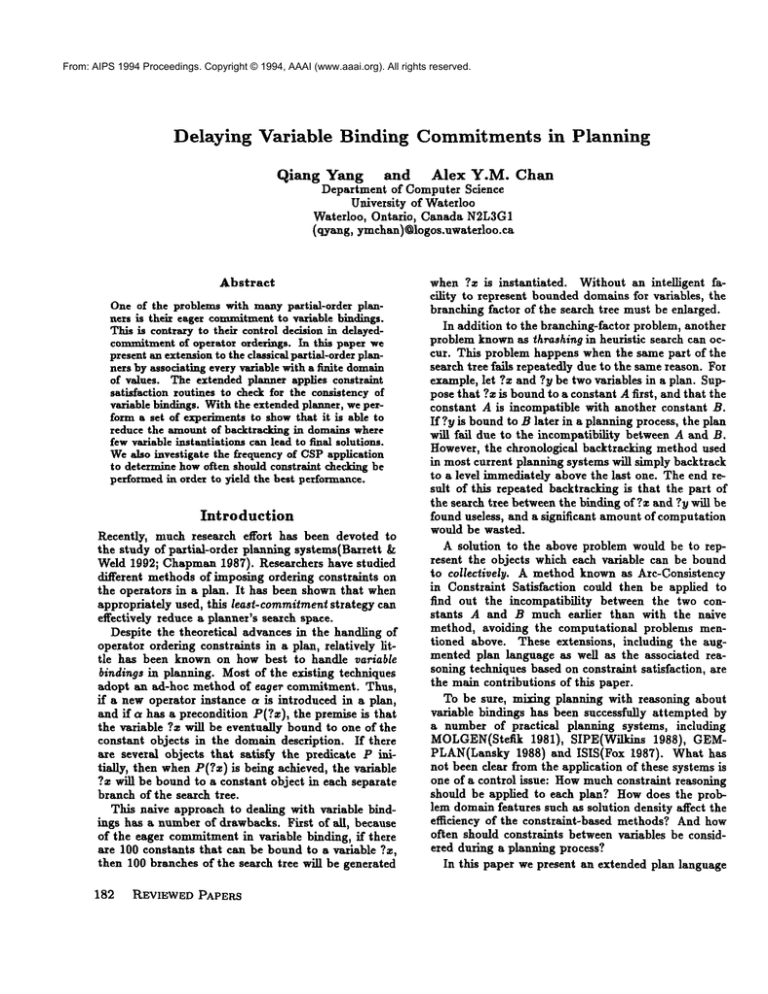
From: AIPS 1994 Proceedings. Copyright © 1994, AAAI (www.aaai.org). All rights reserved.
Delaying
Variable
Qiang
Binding
Yang
and
Alex
Y.M.
Chan
Department of Computer Science
Univexsity of Waterloo
Waterloo, Ontario, Canada N2L3G1
(qyang, ymchan)~logos.uwaterloo.ca
Abstract
One of the problems with manypartial-order planners is their eager commitmentto variable bindings.
This is contrary to their control decision in delayedcommitmentof operator orderings. In this paper we
present an extensionto the classical partial-order planners by associating every variable with a finite domain
of values. The extended planner applies constraint
satisfaction routines to check for the consistency of
variable bindings. Withthe extended planner, we perform a set of experiments to showthat it is able to
reduce the amountof backtracking in domainswhere
few variable instantiations can lead to final solutions.
Wealso investigate the frequency of CSPapplication
to determine howoften should constraint checking be
performedin order to yield the best performance.
Introduction
Recently, much research effort has been devoted to
the study of paxtial-order planning systems(Baxrett
Weld 1992; Chapman1987). Researchers have studied
different methods of imposing ordering constraints on
the operators in a plan. It has been shown that when
appropriately used, this least-commitment strategy can
effectively reduce a planner’s seaxch space.
Despite the theoretical advances in the handling of
operator ordering constraints in a plan, relatively little has been known on how best to handle variable
bindings in planning. Most of the existing techniques
adopt an ad-hoc method of eagez commitment. Thus,
if a new operator instance a is introduced in a plan,
and if a has a precondition P(?z), the premise is that
the variable ?z will be eventually bound to one of the
constant objects in the domain description. If there
axe several objects that satisfy the predicate P initinily, then when P(?z) is being achieved, the variable
?z will be bound to a constant object in each separate
branch of the search tree.
This naive approach to dealing with variable bindings has a number of drawbacks. First of all, because
of the eager commitmentin variable binding, if there
axe 100 constants that can be bound to a vaxiable ?z,
then 100 branches of the search tree will be generated
182
P~EVIEWED PAPERS
Commitments in Planning
when ?z is instantiated.
Without an intelligent facility to represent bounded domains for variables, the
branching factor of the search tree must be enlarged.
In addition to the branching-factor problem, another
problem knownas ~hrashing in heuristic search can occur. This problem happens when the same part of the
search tree fails repeatedly due to the same reason. For
example, let ?z and ?y be two variables in a plan. Suppose that ?z is boundto a constant A first, and that the
constant A is incompatible with another constant B.
If ?y is boundto B later in a planning process, the plan
will fail due to the incompatibility between A and B.
However, the chronological backtracking method used
in most current planning systems will simply backtrack
to a level immediately above the last one. The end result of this repeated backtracking is that the part of
the seaxch tree between the binding of?z and ?y will be
found useless, and a significant amountof computation
would be wasted.
A solution to the above problem would be to represent the objects which each variable can be bound
to collectively.
A method known as Arc-Consistency
in Constraint Satisfaction could then be applied to
find out the incompatibility
between the two constants A and B much eaxlier than with the naive
method, avoiding the computational problems mentioned above. These extensions, including the augmented plan language as we]] as the associated reasoning techniques based on constraint satisfaction, are
the main contributions of this paper.
To be sure, mi~ng planning with reasoning about
variable bindings has been successfully attempted by
a number of practical planning systems, including
MOLGEN(Stefik 1981), SIPE(Wilkins 1988),
PLAN(Lansky 1988) and ISIS(Fox 1987). What
not been clear from the application of these systems is
one of a control issue: Howmuchconstraint reasoning
should be applied to each plan? Howdoes the problem domainfeatures such as solution density affect the
efficiency of the constraint-based methods? And how
often should constraints between variables be considered during a planning process?
In this paper we present an extended plan language
From: AIPS 1994 Proceedings. Copyright © 1994, AAAI (www.aaai.org). All rights reserved.
where each variable is associated with a finite set of domain values. Wealso discuss our planning algorithm
which reasons about these finite variable domains in
each plan and guarantees the soundness and completeness properties. In addition, we present a set of empirical results to demonstrate the efficiency gain of the
extended planner and to answer the above utility question regarding constraint satisfaction.
A Constraint-Based
Planner
In this section, we review the traditional partied order planners and then present our extension using
constraint-based techniques.
Traditional
Partial-order
Planners
A traditional partial order planner represents an operator using a three tuple, a precondition list, an add list,
and a delete list. Eachlist represents a set of literals.
In an operator description, we follow the SNLP(Barrett & Weld 1992) convention to use ?z to denote
variable parameter ?z. In addition to the operators,
a domainis specified using two state descriptions, the
initial state and the goal state. Both states are represented using sets of literals.
shape( ? x
Preconds: 0bj ect (?x)
Adds: Shaped(?x)
Deletes: D~illed(?x),
Painted(?x)
dxill(?x)
Preconds: 0bj ect(?x)
Adds: Drilled(?x)
Deletes: Painted(?x)
paint (?x)
Preconds: Object (?x)
Adds: Stee~(?x)
Deletes: Painted(?x)
As an example, consider a machining domain described by Smith and Peot (Smith & Peot 1992).
The task is to transform a piece of stock into a desired form, by drill;,g,
shaping and painting. The
operators of the domain are listed above. The initial state £" describes a domain where there are 100
pieces of stocks, all of which are objects. In addition, one of the stock is made of steel: 2: :
{Object(Sx),...Object($t00),Steel(Sso)}.
Thus, the
initial state consists of 101literals.
The goal of the domain is to find an object ?y
and perform operations to make it shaped, drilled and
painted: ~ : Shaped(?y), DriIled(?y), Painted(?~).
For a given domaindescription, a traditional partialorder planner invokes a search algorithm to find a plan
from the goal state backwards. A top-level description
of these algorithms is shown below.
1
2
open-list :--- ~ initi~-plan }.
repeat
3
4
5
plan := lowest cost node in open-list;
removeplan from open-list;
if Correct(plan)=True then return plan ;
else
7
If threats exist
8
l~esolve-Threats;
9
else
10
Establish-Precondition(plan);
11
endlf
12
Addsuccessor plans to open-list;
13
endif
14 until open-list is empty;
In this algorithm, the procedure Correct(plan) is
boolean function. For a sound planner, if it returns
True, then the plan must be correct. For the SNLPalgorithm, it is a termination routine that checks to see if
every precondition of every operator has an associated
causal link, and if every causal link is safe(Barrett
Weld 1992).
If plan is not yet correct, then a successor generation process is initiated. The procedure EstablishPrecondition(plan) inserts operators and constraints to
achieve a precondition that has not been satisfied. Let
p(?z) be a precondition of an operator ~ in a plan.
If p(?z) has not yet been satisfied, then a search will
be made to find all existing or new operators a that
have an add-list literal p(?y) such that p(?y) is unifiable with p(?z). For each such operator instance, the
following constraints are imposed on a successor plan:
1. ,~ -~ fl, where -~ represents the precedence relation in the plan.
2. ?z =?y, where = is a binding constraint. ?z =
?y states that ?z and ?y must be bound to exactly
the same constant in all instances of the plan.
The above procedure could be extended to literals with
more than one parameter and literais with constant
parameter.
Extending
the Domain Language
In the previous machine shop example, when achieving Object(?z) we would like to avoid the premature
commitmentof ?z to any particular stock. That is, we
could associate with ?z a domain of values, each value
being a stock stated in the initial state: Domain(?z)
{$1, $2 .... , Sxoo}.To support this consideration, in every plem and every operator we associate each variable
with a domain. A dome~ufor ?z can be a set of objects.
The denotation of Domain(?z) = {Ox, O2,..., On}
that ?z can be bound to any one of O1 through On.
Thus, the concept of a variable domain has a disjunctive or existential meaningto it.
Extending the Planning Algorithm
With the extension of the planning domain language,
the planning algorithm can be extended at two points.
The first extension is in the termination step, Step 5
of the above partial-order planning algorithm. In addiYANO
183
From: AIPS 1994 Proceedings. Copyright © 1994, AAAI (www.aaai.org). All rights reserved.
tionto thetraditional
wayof checking
thecorrectness
Efficiency Gain with the Extended
of a plan,we mustnowmakesurethatforthe setof
Planner
variables
in theplan,eachvariable
canbe assigned
a
We
now
discuss
some
of
the efficiency gains from the
valuefromitsdomain,
suchthatallvariable
binding
extended
planner.
Suppose
that at a certedm planning
constraints
aresatisfied.
step,
we
introduce
an
operator
with a parameter ?z to
To lookat thisproblem
in moredetail,
consider
a
the
plan,
where
?z
can
be
bound
to , different conplanwiththefollowing
setof variables
anddomains.
stants,
al,
a2,...,
an.
If
we
next
insert
another operaThe variables are ?zl, ?z2, and?zs, all with a domain
tor
with
a
parameter
?y
that
can
be
instantiated
to any
{a, 5}. The constraints require that no two variables
of mconstants bl, b2,...bin, then the state space of a
take the same value.
traditional partial-order planner might look like FigFor this problem, there does not exist a consistent
ure 1 (A). In this search tree, the partial-order planner
assignment of the three variables such that all three
commitsto one of al through an at one level, and then
constraints are satisfied. What we would like to add
commits to one of bl through bmat another level. In
in Step 5 is a routine that can tell us whether or not a
the worst case, there are tight constraints on their valconsistent assignmentsexist for al] variables. If not, as
ues which can only be satisfied by constants an and bm
in the case above, then the plan should be discarded.
, and the entire search tree with a size of m * n must
The algorithms that perform this task are known
be scanned.
as Constraint Satisfaction Algorithms. Given a set of
variables, domain values for the variables and constraints amongthem, a constraint satisfaction aigorithm determines whether or not a consistent assignment of values to the variables can be obtained. A
large number of such algorithms have been found(Kumar 1992). For simplicity, we refer to any such algorithm as CSP(p|an). In addition, we refer to the
instance of the plan in which all variables are consis) domO~t)=
at,...an
tently assigned a value Instance(plan).
Anextension of Step 5 is as follows:
5. if Correct(plan)=True, then if CSP(p/an)= True
then return(plan Instance(plan));
The second extension to the planning algorithm is
0 d~?y)=bl,...M
in the Establish-Precondition part (Step 10). First,
add the CSPchecking routine to this part so that nodes
"~"-"bl ... bmbl ... bmbl ... bm
with inconsistent variable bindings can be pruned. For
efficiency purposes, the frequency of CSProutine application here can be specified by the user. Further(A)
(B)
more, whenever a precondition p(?z) is achieved by
operator ~, where ~ adds a literal p(?y), we wouldlike
Figure
I: State spaces of the planners before and after
to make sure that ?z and ?y have an nonempty dothe extension.
main intersection.
Then, we would like the domain of
?z and ?y to be set to that intersection. If, however,
In contrast to the traditional approach, our extended
we are using the initial state literais to achieve p(?z),
constraint-based
planner does not commit to any paxthen we would like to set the domain of ?z to the intitular constant during planning. The domain values
tersection of objects which satisfy predicate p and the
for both ?z and ?lt are simply recorded and reasoned
original domainof ?z. Therefore, all possible constant
bindings for ?z are obtained without committing to a
about at a later time. Therefore the search tree looks
particular one. More precisely, let/8 be an operator
like the one shownin Figure 1 (B).
with precondition p(?z), Establish-Precondition could
In order to conclude that the extended planner
be implemented as follows.
performs better, we must also take into account the
El lfCSP(p|an)= False then return O; Commentto El:
amount of CSP processing done for each node in the
the user specifies hoto often the CSProutine is applied.
search tree. In our extended algorithm, both steps
E2. for all operators aiwhichaddedliteral p(?~);
5 and E1 requited CSP processing. We admit that
E3. ifI)omain(?z) N Domain(?1/) # ~
in the worst case, this would mean that the amount
E4.
generate a successor P~ with a constraint ?z =?It,
of processing per node is exponential. This was the
where Domain(?z) = Domain(?~)are set
reason why Chapman(Chapman1987) specifically
reDora(:-) n Domm(?~).
qnired
that
variables
in
TWEAK
must
not
have
finite
ES. if the initial state containsliterals p(Oj),j = I .... k,
domains of values. However, by avoiding having finite
E6.
then generate a successor plan Q
variable domains, TWEAK
(and SNLP)resorted to try
with Domain(?z) := Domeht(?z)n
out manymore possible variable bindings to find one
{oj,j = ~ ..... k}.
ET.return{Q, Pi, i --- 1, 2,...).
that is consistent, leading to the generation of more
184
REVIEWPDPAPERS
From: AIPS 1994 Proceedings. Copyright © 1994, AAAI (www.aaai.org). All rights reserved.
nodes in the seaxch tree.
To guara~ttee the soundness of the planner, full CSP
reasoning must be applied at step 5. However, if we
want to increase the efficiency of planning, we must
determine, with respect to step El, (1) how m~chconstraint processing should be applied, and (2) how often
should the CSP algorithms be applied.
For the how-m~eh part of the question we have
two choices.
One is to use a polynomial-time
CSP algorithm such as Azc-Consistency(Kumar 1992).
Since the axc-consistency algorithms do not enforce
global consistency, ~nother alternative is to use s
backtracking-based CSP algorithm such as ForwardChecking(Kumax 1992) which has good average-case
performance.
The how-often part of the question is likely dependent on the problem domain features.
One domain
feature is where and how often do dead ends caused
by inconsistent variable bindings occur. If the dead
ends occur early in the search tree, it is mote likely
that variables in aa arbitrary instaati,~tion of a paxtialorder plan cannot be consistently bound to constants.
In this case, applying CSP routines more often could
detect dead ends earlier in search, leading to muchiraproved efficiency. If the dead ends occur deep downin
the search tree or there are in fact no inconsistencies,
the dead end checking routine at Step El is likely to
waste a lot of time with few nodes pruned.
In the next section, we present a set of experiments
to help answer the how-often question while keeping
the ho~o-m~clL issue fixed with an implementation. In
Section 5 we discuss the implications of the results.
le+06 =
,
-
~
10000
f
1000 ."
T .......
100
__.
..........
|0
100
B.................
[] .................
__~:.~ :
m
300
m
500
No, of objects
IS ...........
"
: -~--=--=:::~----I
700
le+06 .
,
m
FSNLP ICSP fre~tenc~:
FSNLP ICSP frequency:
OI -e-IJ -4--SNLP-B--.
100000T
,.°"~
oO°°
I0000
//
oo.°
o,"
,.o’
~
1000 ~
.... .---""~
-
o....--"
o
100 -
..............a-
I
10
2
I
4
3
No. of
5
goals
Figure 3: Exponential Domainwith high solution density
,
,
F~LP ICSPf~equefl~:O)-e--~S~PlCSPfre~enc¥:]}
~-.
SNLP Igood goal order) -B--~LP (poor
goal orde~r~.~
!00000 7
Weld(Barrett & Weld 1992). The new planner, which
we call FSNLP,handles finite variable domains as described in Section 2. In this section, we describe
ou: comparison of SNLPand FSNLPover a range of
domains. Both planners axe implemented in Allegro
CommonLisp on a Sun-4 Spare Station.
In all of the following tests, the subgoais are solved
in a LIFO manner. Whenperforming best-first
search
with both planners, the heuristic function is the sum
of the number of unsafe causal links, the number of
open conditions to be achieved as well as the number
of steps in a plan. The results of the tests are plotted
on two dimensional graphs, where the y-axis, displayed
in log scale, shows the CPUtime required for solving
problems.
900
Figure 2: The Domain of Smith and Peot
Empirical
Results
To test the effectiveness of our approach, we have
extended the SNLP plamler (MeAliester & Rosenblitt 1991) which was implemented by Barrett and
The DomA;n of Sm;th and Peot
The first comparison involves the machine shop domain
described in Section 2. The two planners axe compared
by varying the number of stocks in the initial state.
To obtain aa average result, it is assumedthat for say
n pieces of stocks sl through s,~ the only steel one
is s,~/2. To answer the how-often question raised in
the last section, we also varied the frequency of CSP
application.
Our test result appeaxs in figure 2. In the figure,
FSNLPwith CSP frequencp 0 represents not applying
the CSProutine at Step E1 (first step of EstablishPrecondition) at all. FSNLP~’i~h CSP frequency 1
represents applying the CSProutine for every node.
SNI, P with poor goal order stands for the SNLPplanner with the goal order given in Section 2, whereas
8NI~Pwi~h good goal order represents running the same
SNLPplanner with an ordering of the goal suggested
by Smith and Poet, whereby the pla~ner works on the
subgoal Pain¢ed(f.~l) first. In (Smith & Peot 1992),
YANO 185
From: AIPS 1994 Proceedings. Copyright © 1994, AAAI (www.aaai.org). All rights reserved.
Smith and Peot argued that this good goal order might
be the key to overcome a problem with Knoblock’s abstraction method.
One thing we can observe from the figure is that,
compared to SNLP, FSNLP has a dramatic amount
of improvement in efficiency; in fact its complexity
stays constant as n increases. Another interesting phenomenonis that for this problem, the frequency of CSP
application does not matter. Finally, although a good
goal order can have a dramatic effect on improving
the efficiency of SNLP,goal order alone still cannot
completely close the gap between SNLP and FSNLP.
This further demonstrates the advantage of using the
constraint-based method.
Exponential
Domain
One feature of the above machining domain is that
the size of plans do not increase with the number of
objects. In this section, we consider a~othez domain
which allows us to observe the effect of increasing plan
lengths. The initial and goal states of the domain is
given below.
z = {P(od,..., P(o,-k+d,..., P(o.),
C(o.-h+d,...,C(o.),...,
g = {G(?zl), .... G(?z,),C(?z.)},
wherez, # z i for
i ~ j and 1 _< u _< g. In this domain there are m
objects, n of which satisfy predicate P, and m- n -t- k
of which satisfy C. Of the mobjects k of them satisfy
both predicates. The goal is to find g different objects
that satisfy G. In addition, one of them must also
satisfy C.
Wedefine type O to include all objects in the domain. The operator that allows us to produce Gi from
Pi is as follows 1
achieve-O(?x), Preconditions: P(?x)
Adds: G(?x) Deletes: {}
In the tests, both the initial conditions and goal conditions were randomly permuted. We gathered average results from 10 random problems for each problem
type, with a specific numberof goals in g, g -{- 1, and
with a specific number(denoted by k) of objects which
satisfy both predicates Pi and C.
This domain has a number of interesting features.
First, we can vary the plan lengths by changing the
parameter g, which controls the number of goals. Second, we can vary the density of solution by changing
the number of objects that simultaneously satisfy both
P~ and C. This density is represented by the ratio k/n.
Whenthe density of solution is low, few objects can
satisfy the conjunctive goals Gx(?zz)A C(?zl) in
goal conditions. In this case, SNLPis expected to fail
on most of the branches of the search tree. In contrast,
IThisdomain is slmil~ to DxSI domain described by
Barrett and Weld (Barrett &Weld1992). Ouz experiment
is analogous to the comparison between TOCLand POCL
described in their paper.
186
REVIEWED PAPERS
FSNLPcan avoid the thrashing problem by delaying
the commitment to a particular object and perform
muchbetter. Whenthe density of solution is high, and
when depth-first search is used, we expect that SNLP
is able to zero in onto a solution fast, whereas FSNLP
would still spend extra time for CSPprocessing. Thus,
with depth-first search and whenthe solution density is
high, SNLPwould be slightly better. The low-density
results, under best-first search, ere shownin Figure 3
(the solution density is only 2/10). As we can observe
from the figure, SNLPperforms exponentially worse
than FSNLPas the number of goals increases. The
results under depth-first search strategy are similar in
shape.
Wefurther varied the density of solutions in order to
test the tradeoffs between commitment and the overhead of constraint reasoning. In this test the number
of goals was kept constant to 5, and both planners were
asked to perform depth-first search. The solution density (k/n) is varied from 0/10 to 10/10. The result of
the test is shownin Figure 4. It is interesting to observe
that as the solution density increases, the performance
of SNLPimproves. Eventually SNLP even surpassed
FSNLPin efficiency when the density is 1. This has
a simple explanation: when every instantiation leads
to a correct solution, it does not requite any addition
check by CSP routines. Thus, SNLPcan avoid this
overhead at the high solution density region. In some
other tests, we observed that both SNLPand FSNLP
performed with the same order of time complexities
even when the number of goals was increasing.
Figure 4: Exponential Domainwith varying density
Variable-Sized
Blocks Domain
In the above experiments the search performance of
FSNLPis not very sensitive to the frequency of CSP
application at Step El. Our analysis shows that the
frequency will affect FSNLPwhen dead ends can be
From: AIPS 1994 Proceedings. Copyright © 1994, AAAI (www.aaai.org). All rights reserved.
discovered at varying levels in the planner’s search tree.
To test this hypothesis, we used a blockswofld domain
where there are a number of blocks BI, B2 ..... B. of
unit size, and where there is a particular block A which
can support more than one block. The task is to move
all the B blocks on top of A, using the following operator:
PutonA(?z, ?s); Types: ?z : B; ?s: L;
P~con~,
: Clear( ? z ), S~eO,,A
( ?s
Adds: O,,A(?,); Deletes: S~eO,,A(?,)
In this definition, B is the set of blocks, and L is the
set of locations available on block A, and ?s could be
bound to a location on A. By varying the number of
locations that satisfy the predicate SpaceOnAin the
initial state, we can change where the dead end occurs.
in a search tree. For the test, the numberof blocks is
fixed at 5, and the numberof locations on top of block
A varies from 2 to 5. The dead end occurs very high
up in the search tree if the number of locations is 2,
and deep in the search tree if the number of locations
is 4. Whenthe number of locations is 5, all 5 blocks
can be put on object A at the same time on different
locations, and no dead end occurs.
100000
,
zoooo ~ [] .~.we----~
100
i
0
0.2
Pr~ency
.
,
,
F~LP lno.
of locations:
F~LP
lno. of locations:
FS~P
{no. of locations:
F~P
|no. of locations:
2)
3)
4)
5)
+--~--.
-~--
..........
i
i
i
0.4
0.6
0.8
of co.fete CSP app]ication
Figure 5: Performance in Variable-Sized
main
t
Blocks Do-
Figure 5 depicts the results, where the frequency of
CSPapplication refers to the inverse of the number of
nodes along a search path between any two successive
CSPapplications at Step El. The frequency is I ifCSP
is applied to every node. If CSPis not applied to any
nodes at all, the frequency is 0. The figure shows that
when the dead end occurs early in the search tree, for
example, when the number of locations is 2 (the solid
~ne in the figure), the CPUtime consumedis in inverse
proportion to the frequency of solving the CSP. In the
opposite case, situation is reversed: the CPUtime used
is in direct proportion to the frequency of solving the
constraint network, implying that it is better to apply
CSPchecking infrequently.
Conclusions
In this paper we presented an extension to classical
partial-order
planners by applying CSPalgorithms.
The advantage of this approach derives from delayed
commitment for variable bindings which is symmetric to the advantage of partiai-order planners over the
total-order ones. From the experiments we observed a
tremendous improvement of efficiency in general with
our planner FSNLPover SNLP. Wealso see that the
effectiveness of applying constraint satisfaction algorithms depends on where dead ends occur in the search
tree. Weaxe currently performing more extensive
experiments(Chan 1994) to further validate this approach.
Acknowledgement
This work is supported by a grant from Natural Sciences and Engineering Research Council of Canada
References
Barrett, A., and Weld, D. 1992. Partial order planning: Evaluating possible efficiency gains. Technical
Report 92-05-01, University of Washington, Department of Computer Science and Engineering, Seattle,
WA98105.
Chan, A. Y. 1994. Variable binding commitments
in planning. Master’s thesis, University of Waterloo, Department of Computer Science, Waterloo, Ont.
Canada.
Chapman, D. 1987. Planning for conjunctive goals.
A~tificial Intelligence 32:333-377.
Fox, M. 1987. Constraint-Directed Search: A Case
Study of Job-Shop Scheduling. Morgan Kaufmann.
Kumar, V. 1992. Algorithms for constraint satisfaction problems: A survey. AI Magazine Spring~
1992:32--44.
Lansky, A. L. 1988. Localized event-based reasoning
for multiagent domains. Computational Intelligence
4(4).
McAllester, D., and Rosenblitt, D. 1991. Systematic
nonll-eaz planning. In Proceedings of the Ninth National Conference on Artificial Intelligence (AAAI91), 634-639. San Mateo, CA: Morgan Kaufmann
Publishers, Inc.
Smith, D. E., and Peot, M. A. 1992. A critical look
at kuoblock’s hierarchy mechanism. In Proceedings
of the First Inler~alional Conference on AI Planning
Systems, 307-308.
Stefik, M. 1981. Planning with constraints. Artificial
Intelligence 16(2):111-140.
Wflkins, D. 1988. Practical Planning: Eztending the
Classical AI Planning Paradigm. San Mateo, CA:
Morgan Kaufmann Publishers, Inc.
YANG 187




